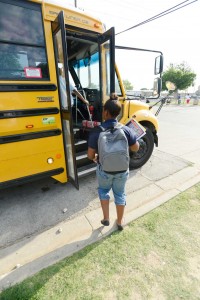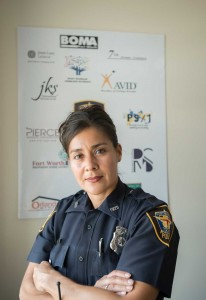The city’s latest tally of homeless kids was 739 — enough to fill an elementary school. But the city counts only children who enter a shelter and meet the U.S. Department of Housing and Urban Development definition for homelessness. The Fort Worth school district count of homeless kids is 1,943. And even that is probably low, some officials said.

Each year students in the district are required to fill out a residency questionnaire. The data help the district determine who is eligible for homeless assistance
“The questionnaire is part of the student information packet that is sent home with all students at the beginning of the year,” said June Davis, homeless liaison for the district. Since being homeless is an embarrassing admission, she figures actual numbers are considerably higher.
Shelters like Union Gospel and Presbyterian provide services for the kids who stay there. Presbyterian is the only “no turn-away shelter” on East Lancaster, meaning that individuals of any religious affiliation, age, or pre-existing condition are admitted (except those who are obviously intoxicated). Both shelters offer a wide array of help such as counseling, education, case management, and life-skills training.
The school district provides a full-time teacher at ACH, as well as clothing, school uniforms, school supplies, tutoring, assistance with school fees, transportation, and help with vision and medical needs.
For homeless kids who live totally outside the system, the first contact with Fort Worth’s safety net usually begins with the Street Outreach Team from ACH.
“The street outreach team finds youths [through] direct contact on the street, in malls, parks, and other public areas,” said Carla Storey, director of residential services for ACH.
“There are plenty of kids on the street who aren’t ready to come into a shelter necessarily,” said Jessica Sorenson, leader of the team. “So we provide services for them while they’re in transition on the street.” She sees the team’s work as crucial to that segment of homeless kids.
These services include a possibly life-saving contact information badge, which provides instructions on how teens can text their current location to a listed number for immediate help, a toll-free help hotline, and the address of ACH’s 24-hour youth shelter.
“We spend a whole lot of time in the East Lancaster area,” Sorenson said. “We also spend a lot of time networking with schools.”
ACH manages the only shelter in the county exclusively for runaway and homeless youth. Some of the children they help are rescued by the street team; others are dropped off by overwhelmed parents who can no longer afford to provide for them or, in some cases, deal with their problems.
Because couch-hopper kids technically have places to stay, they are ineligible for certain homeless benefits under HUD guidelines.
Regardless, their needs are still dire. That reality has led to a number of collaborations among Fort Worth organizations, particularly the school district and Fort Worth police.
“There are many dangers [for such kids], from being approached by drug dealers to turning to a life of prostitution to survive,” said Fort Worth Police Officer Julie Cox, the department’s homeless liaison officer. “For these youth, there are no legitimate ways to make money.”
In March, Cox got her department and the school district to collaborate on the opening of Care Closet, a nonprofit store at Arlington Heights High School that provides free clothing to homeless and at-risk youth.
“The police department works closely with the [district’s] homeless liaison in an effort to get in front of the issues that arise in these young kids’ lives,” she said. “These students have a difficult enough situation. A set of clean clothes, toiletries, a backpack — things other kids take for granted — can mean so much.
“Our goal is to give these kids what they need to survive and to help them reach the goals they have in life. All we are trying to do is give them a chance, and they deserve that.”
The school district provides identified homeless students with school supplies, transportation assistance, and medical help.
Clint Bond, the school district’s director of communications, said the district is trying to respond to an alarming increase in the number of homeless students.
One tool that helps disadvantaged students is summer school. Those classes offer homeless kids — whose living situation often causes them to fall behind — a way to make up for lost time in the classroom.
Because summer school requires tuition, Gill Children’s Services steps in. The Gill organization helps pay tuition for kids who need the summer classes to advance to the next grade. Beyond that, the group serves as a safety net for homeless children who have medical, dental, social, or emotional needs that are not being addressed by their family or caregiver or another agency.
“When a child is homeless or the family moves often, this presents its own challenges for children and inhibits their ability to learn,” said Gill executive director Amanda Stallings.
********
Former Fort Worth Mayor Mike Moncrief made a real impact in the fight to shrink Fort Worth’s homeless population. According to the Tarrant County Homeless Coalition, between 2007 and 2011 his administration oversaw a decrease in Fort Worth’s homeless population by 23 percent.

In an attempt to keep up the momentum begun with Directions Home, the city’s homeless advisory group in May launched another effort, called The Shortest Way Home. It’s designed to get everyday residents involved. One event, Clean for a Cause, encourages residents to host garage sales on Aug. 10 to benefit agencies involved in serving the homeless.
Less widely known than Directions Home is Moncrief’s involvement in getting Cook Children’s to become community leaders in helping Fort Worth’s homeless child population. In the fall of 2007 Moncrief led several senior executives of the healthcare system to East Lancaster so they could see the needs of Fort Worth’s homeless child population firsthand.
At that time, as is still often the case, impoverished mothers and children were resorting to emergency rooms for basic medical care. To everyone’s surprise, a great amount of attention was being paid to parents and little to the needs of children in the shelters. Homeless kids, not surprisingly, are far more susceptible to illness than other children. Asthma, respiratory infections, and stomach problems are among the most common ailments.
One Cook director took the lesson to heart.
“The staff from the shelters said that the health needs of the children were not consistently being met,” said Ginny Hickman, assistant vice president for community health outreach. “That’s why we created a ‘medical home’ for these children at the Cook Children’s neighborhood clinics while they were living in the shelters, with a goal of the families using that same medical home for their children when they moved out of the shelters.”
A comprehensive program called Cook Children’s Homeless Initiative was developed. The following year, Cook Children’s added a nurse case manager and social worker case manager to directly serve Fort Worth’s homeless kids.
The goal of the initiative is to build connections among homeless families and the five neighborhood clinics. Cook Children’s system serves an average of 805 homeless children per year.
********
Physical ailments aren’t the only health problems facing homeless children. Sexual exploitation and illicit drug use are ever-present dangers. Those problems, plus the psychic toll of homelessness itself, can affect their mental health.
“Being homeless is in itself a form of trauma,” said Zettler, the Cook director of psychology. Homeless kids are much more likely to have emotional and behavioral problems than children with stable homes, she said.
But it’s hard to address mental health problems until a child’s more basic needs are being met.
“If a kid is hungry, then play therapy isn’t going to take root,” she said.
Cook Children’s has provided training for staffers at Presbyterian, Union Gospel, and other shelters in the basics of “trauma-informed care,” which is based on an understanding of the biological, psychological, neurological, and social effects of trauma.
“Just because you experience trauma does not mean you will be [affected] forever,” Zettler said. “There is a large proportion of traumatized kids who are resilient. Those kids do very well.
“As great as Cook Children’s is, we can’t do everything,” she added. “Schools help by giving goals, increasing resiliency. Churches, clubs, mentoring –– all increase resiliency.”
********
Leaders of such programs are worried that their recent steps forward in dealing with homelessness may be erased by a giant step back in funding, caused mostly by the federal across-the-board cuts known as the sequester.
The housing choice voucher program, for example, probably will be able to help 90 fewer households this year than last, due to sequestration cuts. That’s a smaller cutback than expected, only about 2 percent; HUD expects housing authorities to use reserve funds to cushion the blow. The program helps qualified families with rent: The families pay 30 percent of their adjusted income toward rent, and the Fort Worth Housing Authority pays the rest.
Another program under the knife is called Shelter Plus Care. Similar to the rent voucher program, Shelter Plus Care is exclusively for the homeless and disabled.
“Because of a reduction in funding to the Tarrant County Homeless Coalition, there was a reduction to the FWHA Shelter Plus Care program. Consequently, [that program] will serve approximately 120 fewer households,” said Selarstean Mitchell, the housing authority’s vice president for assisted housing. And the homeless aren’t the only ones feeling the effects: FWHA staffers are dealing with furloughs and pay cuts.
“Effective May 2013, staff went to a four-day work week,” Mitchell said. “This is resulting in a 20 percent reduction in pay for employees. The offices are closed every Friday.”
The network of support services for the homeless in Fort Worth isn’t seamless, but it’s much more extensive than it was a decade ago, thanks to the broad range of agencies that have combined their efforts.
People like Klocek, at the YWCA, worry that the high proportion of children among the homeless is becoming the norm. National statistics show how easy it is for homelessness to get passed down: 44 percent of homeless mothers experienced homelessness or foster home situations as children.
Poor and homeless kids “lead very different lives from the more fortunate children in our society,” said Justin Dyniewski, psychiatrist with Mental Health Mental Retardation of Tarrant County. “They are exposed to numerous stressors that put them at increased risk of developing mental health disorders.”
“Homelessness is no place to grow up,” Klocek said.
Fort Worth freelance writer Edward Brown can be reached at ejb0017@yahoo.com.












I’ve been both a client and a social worker at some of these agencies. They do a great job with what resources they have. What would really help clients is if Arlington had a public transportation system. This lack is a huge failing and puts Arlington in a shameful light.